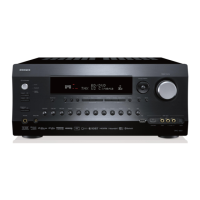Advanced Operations
En-68
Operating procedure (➔ page 59)
■ TrueHD Loudness Management
` Off
` On
This setting specifies whether or not to apply the Late
Night processing on a Dolby TrueHD source.
Note
• When this setting is set to “Off”, the Late Night function for
Dolby TrueHD sources is automatically fixed to “Off”.
• When this setting is set to “Off”, the Dialogue Normalization
information is not available for Dolby TrueHD sources.
DTS
■ Neo:X Music
Center Image
` 0 to 2
to 5
The DTS Neo:X Music listening mode creates
7-channel surround sound from 2-channel stereo
sources. With this setting, you can specify by how
much the front left and right channel output is
attenuated in order to create the center channel.
Changing the value from “0” to “5” will spread the
sound of the center channel to left and right
(outwards).
Audyssey DSX
®
■ Soundstage
` –3dB to Reference
to +3dB
With this setting, you can adjust the sound stage
when using Audyssey DSX.
Note
• This listening mode can be selected only when all the
following conditions are satisfied:
– The center speaker is connected.
– Either the front high or front wide speakers are connected.
Theater-Dimensional
■ Listening Angle
` Wide
:
Select if the listening angle is greater than 30
degrees.
` Narrow:
Select if the listening angle is less than 30
degrees.
With this setting, you can optimize the Theater-
Dimensional listening mode by specifying the angle of
the front left and right speakers relative to the
listening position. Ideally, the front left and right
speakers should be equidistant from the listening
position and at an angle close to one of the two
available settings.
Note
• For best results, we recommend setting “
Narrow” to 20°
and “Wide” to 40°.
LFE Level
■ Dolby Digital
*1
, DTS
*2
, Multich PCM, Dolby
TrueHD, DTS-HD Master Audio, DSD
*3
` –QdB, –20dB, –10dB, or 0dB
With these settings, you can set the level of the LFE
(Low Frequency Effects) channel individually for each
input sources.
If you find that low-frequency effects are too loud
when using one of these sources, change the setting
to –20 dB or –Q dB.
*1
Dolby Digital and Dolby Digital Plus sources
*2
DTS and DTS-HD High Resolution sources
*3
DSD (Super Audio CD) sources
Sound Program Edit
■ Sound Program
` Stereo Source 1, Stereo Source 2, Stereo
Source 3, Multich Source 1, Multich Source 2,
Multich Source 3
When playing back different content types on the
same source, or when listening to a single content
type on different sources, you can pre-register the
settings that best suit each content in “Sound
Program”. The registered settings can then be called
up and modified in one set. Use “Sound Program
Edit” to register and modify a combination of settings.
Tip
• To select the registered settings, see “Sound Program”
(➔ page 56).
■ Listening Mode
You can assign a default listening mode that will be
selected automatically when you select the sound
program.
The “Last Valid” option means that the listening
mode selected last will be used.
The “Straight Decode” option means that straight
decoding listening mode (Dolby Digital, DTS, etc.) is
selected.
■ Subwoofer
` No, Yes
You can choose whether or not to use the subwoofer
with the sound program.
■ Music Optimizer
*1
` Off, On
See “Music Optimizer” (➔ page 58).
Front left speaker Front right speaker
Listening angle: 30°

